|
|
|
Sort Order |
|
|
|
Items / Page
|
|
|
|
|
|
|
| Srl | Item |
| 1 |
ID:
091512
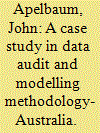

|
|
|
|
|
| Publication |
2009.
|
| Summary/Abstract |
The purpose of the paper is to outline a rigorous, spatially consistent and cost-effective transport planning tool that projects travel demand, energy and emissions for all modes associated with domestic and international transport. The planning tool (AuseTran) is a multi-modal, multi-fuel and multi-regional macroeconomic and demographic-based computational model of the Australian transport sector that overcomes some of the gaps associated with existing strategic level transport emission models. The paper also identifies a number of key data issues that need to be resolved prior to model development with particular reference to the Australian environment. The strategic model structure endogenously derives transport demand, energy and emissions by jurisdiction, vehicle type, emission type and transport service for both freight and passenger transport. Importantly, the analytical framework delineates the national transport task, energy consumed and emissions according to region, state/territory of origin and jurisdictional protocols, provides an audit mechanism for the evaluation of the methodological framework, integrates a mathematical protocol to derive time series FFC emission factors and allows for the impact of non-registered road vehicles on transport, fuel and emissions.
|
|
|
|
|
|
|
|
|
|
|
|
|
|
|
|
| 2 |
ID:
084302
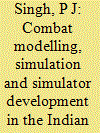

|
|
|
| 3 |
ID:
191309
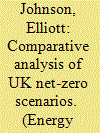

|
|
|
|
|
| Summary/Abstract |
Final energy demand in the UK has remained relatively constant since the 1970s. However, most of the scenarios that model pathways to achieve the UK's net-zero greenhouse gas emissions by 2050 indicate that energy demand reduction (EDR) will be an important pillar of climate change mitigation. Despite this, the UK Government has no clearly defined strategy to reduce demand. This comparative analysis explores the role of EDR across twelve UK-based climate scenarios from four organisations that estimate changes in carbon emission and energy consumption from 2020 to 2050. We focus on changes in final demand across the economy, assessing the scale of ambition and the implications for the rest of the energy system in the context of net-zero. All the pathways explored achieve reductions of at least 32.8% in total final energy demand from 2020 to 2050, suggesting that this is the minimum level of demand reduction required to achieve the development and rollout of the supply side technologies necessary to decarbonise the energy system. Reductions in total final demand of up to 52% are demonstrated. We find that pathways with higher levels of EDR mitigate against technological challenges, such as scaling up renewable energy capacities, are less reliant on carbon-dioxide removal technologies and require less investment – but are characterised by higher levels of social change.
|
|
|
|
|
|
|
|
|
|
|
|
|
|
|
|
| 4 |
ID:
149012


|
|
|
|
|
| Summary/Abstract |
This research compares 3D versus 4D (three spatial dimensions and the time dimension) multi-objective and multi-criteria path-planning for unmanned aerial vehicles in complex dynamic environments. In this study, we empirically analyse the performances of 3D and 4D path planning approaches. Using the empirical data, we show that the 4D approach is superior over the 3D approach especially in complex dynamic environments. The research model consisting of flight objectives and criteria is developed based on interviews with an experienced military UAV pilot and mission planner to establish realism and relevancy in unmanned aerial vehicle flight planning. Furthermore, this study incorporates one of the most comprehensive set of criteria identified during our literature search. The simulation results clearly show that the 4D path planning approach is able to provide solutions in complex dynamic environments in which the 3D approach could not find a solution.
|
|
|
|
|
|
|
|
|
|
|
|
|
|
|
|
| 5 |
ID:
124693
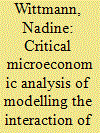

|
|
|
|
|
| Publication |
2013.
|
| Summary/Abstract |
This paper presents an alternative approach to a graphical analysis of the interaction of White Certificates with the EU emission trading scheme as the approach of Sorrell et al. (2009a contains the following aspects that require some clarification: first, the issue of a clearer distinction between conventional and alternative energy supply is brought up. Second, the concept of a minimum requirement for energy demanded is discussed. Third, the correlation between demand for energy and demand for energy efficiency measures is displayed in a more intuitive manner. The effects of introducing WCTS and EU ETS into the market setting are then analyzed accordingly.
|
|
|
|
|
|
|
|
|
|
|
|
|
|
|
|
| 6 |
ID:
191369
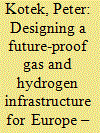

|
|
|
|
|
| Summary/Abstract |
Hydrogen has been at the centre of attention since the EU kicked-off its decarbonization agenda at full speed. Many consider it a silver bullet for the deep decarbonization of technically challenging sectors and industries, but it is also an attractive option for the gas industry to retain and future-proof its well-developed infrastructure networks. The modelling methodology presented in this report systematically tests the feasibility and cost of different pipeline transportation methods – blending, repurposing, and dedicated hydrogen pipelines - under different decarbonization pathways and concludes that blending is not a viable solution and pipeline repurposing can lead to excessive investment outlays in the range of EUR 19–25 bn over the modelled period (2020–2050) for the EU-27.
|
|
|
|
|
|
|
|
|
|
|
|
|
|
|
|
| 7 |
ID:
192764
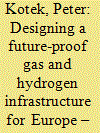

|
|
|
|
|
| Summary/Abstract |
Hydrogen has been at the centre of attention since the EU kicked-off its decarbonization agenda at full speed. Many consider it a silver bullet for the deep decarbonization of technically challenging sectors and industries, but it is also an attractive option for the gas industry to retain and future-proof its well-developed infrastructure networks. The modelling methodology presented in this report systematically tests the feasibility and cost of different pipeline transportation methods – blending, repurposing, and dedicated hydrogen pipelines - under different decarbonization pathways and concludes that blending is not a viable solution and pipeline repurposing can lead to excessive investment outlays in the range of EUR 19–25 bn over the modelled period (2020–2050) for the EU-27.
|
|
|
|
|
|
|
|
|
|
|
|
|
|
|
|
| 8 |
ID:
168654
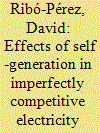

|
|
|
|
|
| Summary/Abstract |
Domestic rooftop photovoltaic (PV) energy can reduce net electricity demand, and therefore reduce energy prices through a merit-order effect. This reduces profits of all incumbents in the electricity markets. In addition, in imperfectly competitive markets, PV self-generation reduces prices through a reduction in market power. The first effect may warrant additional policy interventions to maintain cost recovery, but the second is much more desirable, as it simultaneously helps increase sustainability and competition. However, unlike a simple reduction in market prices, the competition effect affects all incumbents differently. Since resistance from incumbents can be a significant barrier to energy policy change, it is important to understand the distribution of effects. This paper does so for the Spanish market. A Nash-Cournot model and a simplified representation of the Spanish electricity market is used to determine the merit-order and competition effects of an increase in solar self-generation. We conclude that both are important, and that their analysis is essential to inform the social debate around PV policy.
|
|
|
|
|
|
|
|
|
|
|
|
|
|
|
|
| 9 |
ID:
171470
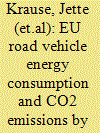

|
|
|
|
|
| Summary/Abstract |
To inform long-term policies on transport decarbonisation, the present paper analyses European road transport CO2 emission reduction options by 2050. The investigation focusses on measures improving tank to wheel vehicle efficiency, but takes into account upstream emissions of electric vehicles. Measures for vehicle efficiency improvement, transport smoothing, and transport reduction, as well as possible 2050 road vehicle fleet compositions have been quantified through expert group discussion and combined with fleet impact modelling to calculate scenario results.
Outcomes show that tank to wheel road transport CO2 emission reductions up to 90% versus 1990 could be reached by 2050 through strong fleet electrification and if all measures achieve their best potential. Under ambitious fleet electrification scenarios, CO2 reduction of more than 60% is reached without measures, but causes substantial additional demand for low-carbon electricity, the availability of which is not covered in this paper. It is likely that policies will be a prerequisite for fleet electrification and efficiency increases of the order of magnitude assumed. Moreover, upstream CO2 emissions of electricity for battery and plug-in hybrid electric vehicles could add up to 40% of tank to wheel emissions, suggesting that complementary policies are needed to avoid shifting transport emissions to other sectors.
|
|
|
|
|
|
|
|
|
|
|
|
|
|
|
|
| 10 |
ID:
109599


|
|
|
|
|
| Publication |
2011.
|
| Summary/Abstract |
Recently, an active debate has emerged around greenhouse gas emissions due to indirect land use change (iLUC) of expanding agricultural areas dedicated to biofuel production. In this paper we provide a detailed analysis of the iLUC effect, and further address the issues of deforestation, irrigation water use, and crop price increases due to expanding biofuel acreage. We use GLOBIOM - an economic partial equilibrium model of the global forest, agriculture, and biomass sectors with a bottom-up representation of agricultural and forestry management practices. The results indicate that second generation biofuel production fed by wood from sustainably managed existing forests would lead to a negative iLUC factor, meaning that overall emissions are 27% lower compared to the "No biofuel" scenario by 2030. The iLUC factor of first generation biofuels global expansion is generally positive, requiring some 25 years to be paid back by the GHG savings from the substitution of biofuels for conventional fuels. Second generation biofuels perform better also with respect to the other investigated criteria; on the condition that they are not sourced from dedicated plantations directly competing for agricultural land. If so, then efficient first generation systems are preferable. Since no clear technology champion for all situations exists, we would recommend targeting policy instruments directly at the positive and negative effects of biofuel production rather than at the production itself.
|
|
|
|
|
|
|
|
|
|
|
|
|
|
|
|
| 11 |
ID:
191219


|
|
|
|
|
| Summary/Abstract |
Hydrogen can be key in the energy system transition. We investigate the role of offshore hydrogen generation in a future integrated energy system. By performing energy system optimisation in a model application of the Northern-central European energy system and the North Sea offshore grid towards 2050, we find that offshore hydrogen generation may likely only play a limited role, and that offshore wind energy has higher value when sent to shore in the form of electricity. Forcing all hydrogen generation offshore would lead to increased energy system costs. Under the assumed scenario conditions, which result in deep decarbonisatiton of the energy system towards 2050, hydrogen generation – both onshore and offshore – follows solar PV generation patterns. Combined with hydrogen storage, this is the most cost-effective solution to satisfy future hydrogen demand. Overall, we find that the role of future offshore hydrogen generation should not simply be derived from minimising costs for the offshore sub-system, but by also considering the economic value that such generation would create for the whole integrated energy system. We find as a no-regret option to enable and promote the integration of offshore wind in onshore energy markets via electrical connections.
|
|
|
|
|
|
|
|
|
|
|
|
|
|
|
|
| 12 |
ID:
126566


|
|
|
|
|
| Publication |
2013.
|
| Summary/Abstract |
This paper presents results from modelling work investigating the effects of social networks on the adoption of energy technologies in the domestic sector. This work concerns ideas on social network interventions which have been successfully applied in other domains but which have seldom been applied to energy policy questions. We employ a dynamical multi-parameter network model where households are represented as nodes on a network for which the uptake of technologies is influenced by both personal benefit and social influences. This is applied to demonstrate the usefulness of this type of model in assessing the likely success of different roll-out strategies that a local authority could pursue in promoting the uptake of domestic energy technologies. Local authorities can play a key role in the retrofit of energy-efficiency and low-carbon energy-generation technologies in order to realise carbon reductions and alleviate fuel poverty. Scenarios are modelled for different local authority interventions that target network interactions and uptake threshold effects, and the results provide insights for policy. The potential for the use of this type of modelling in understanding the adoption of energy innovations in the domestic sector and designing local-level interventions is demonstrated.
|
|
|
|
|
|
|
|
|
|
|
|
|
|
|
|
| 13 |
ID:
137681
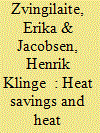

|
|
|
|
|
| Summary/Abstract |
The trade-off between investing in energy savings and investing in individual heating technologies with high investment and low variable costs in single family houses is modelled for a number of building and consumer categories in Denmark. For each group the private economic cost of providing heating comfort is minimised. The private solution may deviate from the socio-economical optimal solution and we suggest changes to policy to incentivise the individuals to make choices more in line with the socio-economic optimal mix of energy savings and technologies.The households can combine their primary heating source with secondary heating e.g. a woodstove. This choice results in increased indoor air pollution with fine particles causing health effects. We integrate health cost due to use of woodstoves into household optimisation of heating expenditures.The results show that due to a combination of low costs of primary fuel and low environmental performance of woodstoves today, included health costs lead to decreased use of secondary heating. Overall the interdependence of heat generation technology- and heat saving-choice is significant. The total optimal level of heat savings for private consumers decrease by 66% when all have the option to shift to the technology with lowest variable costs.
|
|
|
|
|
|
|
|
|
|
|
|
|
|
|
|
| 14 |
ID:
091517
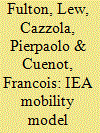

|
|
|
|
|
| Publication |
2009.
|
| Summary/Abstract |
The IEA published "Energy Technology Perspectives" (ETP) in June 2008. That document reports on IEA scenarios for baseline and low-CO2 alternative scenarios to 2050, across the energy economy. The study included creating scenarios for transport, using the IEA Mobility Model (MoMo). This paper reports on the transport-related ETP scenarios and describes the model used in the analysis. According to the ETP Baseline scenario, world transport energy use and CO2 emissions will more than double by 2050. In the most challenging scenario, called "BLUE", transport emissions are reduced by 70% in 2050 compared to their baseline level in that year (and about 25% below their 2005 levels). There are several versions of the BLUE scenario, but all involve: a 50% or greater improvement in LDV efficiency, 30-50% improvement in efficiency of other modes (e.g. trucks, ships and aircraft), 25% substitution of liquid fossil fuels by biofuels, and considerable penetration of electric and/or fuel-cell vehicles. In the second half of this paper, an overview of the MoMo model is provided. Details on the complete analysis are contained in the ETP 2008 document, available at www.iea.org. Details of the LDV fuel economy analysis are contained in a separate paper in this collection.
|
|
|
|
|
|
|
|
|
|
|
|
|
|
|
|
| 15 |
ID:
124504


|
|
|
|
|
| Publication |
2013.
|
| Summary/Abstract |
The European electricity market is linked to a carbon market with a fixed cap that limits greenhouse gas emissions. At the same time, a number of energy efficiency policy instruments in the EU aim at reducing the electricity consumption. This article explores the interactions between the EU's carbon market on the one hand and instruments specifically targeted towards energy end-use efficiency on the other hand. Our theoretical analysis shows how electricity demand reduction triggered by energy efficiency policy instruments affects the emission trading scheme. Without adjustments of the fixed cap, decreasing electricity demand (relative to business-as-usual) reduces the carbon price without reducing total emissions. With lower carbon prices, costly low emission processes will be substituted by cheaper high emitting processes. Possible electricity and carbon price effects of electricity demand reduction scenarios under various carbon caps are quantified with a long-term electricity market simulation model. The results show that electricity efficiency policies allow for a significant reduction of the carbon cap. Compared to the 2005 emission level, 30% emission reductions can be achieved by 2020 within the emission trading scheme with similar or even lower costs for the industrial sector than were expected when the cap was initially set for a 21% emission reduction.
|
|
|
|
|
|
|
|
|
|
|
|
|
|
|
|
| 16 |
ID:
149902
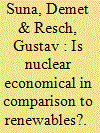

|
|
|
|
|
| Summary/Abstract |
The European Union is divided on the issue of electricity production. While there is consensus that generation technologies need to be low on greenhouse gas emissions, the question of whether to use renewables or nuclear to meet this power demand is highly controversial. Both options still require financial support and this is not going to change in the near future. This raises the question of where public money should be invested in order to achieve greater economic efficiency: into support for renewable energies (RE) or support for nuclear power plants?
|
|
|
|
|
|
|
|
|
|
|
|
|
|
|
|
| 17 |
ID:
163561
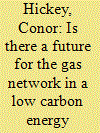

|
|
|
|
|
| Summary/Abstract |
This paper evaluates the potential low carbon opportunities for and challenges to the utilisation and financial performance of Ireland's gas distribution network within a series of low carbon scenarios. There has been a limited amount of academic literature published on the future implications of gas demand on gas networks. This paper takes the unique perspective of assessing the stranded asset risk to a utility operating a gas network in the context of a low carbon energy system. Building on established emissions reduction scenarios, a financial model is developed from an integrated energy system model to understand the financial risks associated with continued investment in gas networks. We find that higher network tariffs are required for consumers in the future to cover network costs, even though gas consumption grows relative to current consumption levels in low carbon scenarios with carbon capture and storage.
|
|
|
|
|
|
|
|
|
|
|
|
|
|
|
|
| 18 |
ID:
171436
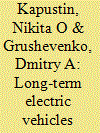

|
|
|
|
|
| Summary/Abstract |
The last decade was marked by a new boom of popularity for electric transport. Massive government support helped increase EV annual sales from just 2 to over 753 thousands worldwide over the ten years. Many countries and private enterprises hold extremely high hopes for electric transport, predicting the imminent abandonment of the internal combustion engines (ICE). Our research shows that in 2018 EVs are yet still unable to compete on equal footing with conventional cars. However, should government and auto manufacturers maintain the current pace of development, true competitiveness between ICE and electric vehicles can be achieved by 2035 even in the low-oil-price environment.
Our calculations indicate that by 2040, depending on the scenario, the EVs can secure an 11–28% share of the global road transport fleet. This will lead to an additional increase in global electricity consumption of 11–20%. The challenge, however, is the adaptation of power grid to the growing demand peaks due to EVs charging patterns. To maintain the course on “green” energy, global leaders in EV adoption need to double the efforts on development and implementation of energy storage technologies, otherwise, the spread of electric cars will lead to more fossil fuel consumption.
|
|
|
|
|
|
|
|
|
|
|
|
|
|
|
|
| 19 |
ID:
098679
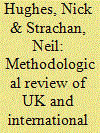

|
|
|
|
|
| Publication |
2010.
|
| Summary/Abstract |
Scenarios have a long history in business, politics and military planning, as a tool for strategic planning to inform protective, proactive or consensus-based decision making in the face of uncertain futures. Recent years have seen a growth in scenarios for assessing the implications of low carbon futures, but relatively little work has linked these energy scenarios to the broader literature on scenario development. This paper undertakes a methodological review of a selection of UK and international low carbon scenario studies, using a typology of 'trend based', 'technical feasibility' and 'modelling' studies. Dominant methodologies in such studies have been the 2×2 axis and the 'back-casting' approach. Strengths of the studies reviewed include technological detail, and identification of key economic and social constraints. Weaknesses include the over-reliance on constructs such as exogenous emissions constraints, and high level trends, which diminish the ability to understand how the various future scenarios could be brought about or avoided. This is compounded by the lack of depiction of specific system actors; the tendency to abstract policy from the scenarios; and the resulting failure to consider policy, technology and behaviour in an iterative, 'co-evolving' fashion.
|
|
|
|
|
|
|
|
|
|
|
|
|
|
|
|
| 20 |
ID:
121326
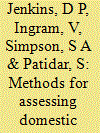

|
|
|
|
|
| Publication |
2013.
|
| Summary/Abstract |
Due to both changing building design and projected climate change, the conditions within dwellings in the UK are likely to show increased risk to overheating. There is therefore a growing requirement for a suitable industry standard to assess overheating risk in the domestic sector, ensuring that both new dwellings and refurbishments to existing dwellings take future climate into account. This study compares the type of advice gained and the form of calculation used for a series of different summertime overheating analyses. Using simple overheating definitions, a case-study dwelling is simulated for two UK locations across different climate scenarios and the consistency in advice provided by the chosen methods is discussed. The results suggest there are issues around the consistency of such varied models, but also highlight the need to strike a balance between a method that reliably accounts for building thermal performance while also providing a clear and useable approach that can be adopted within industry practice.
|
|
|
|
|
|
|
|
|
|
|
|
|
|
|
|
|
|
|
|
|